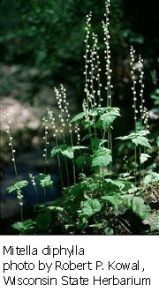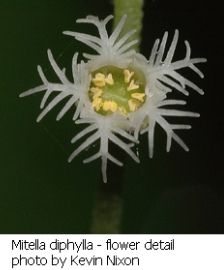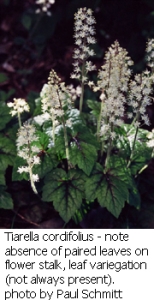Two-Leaved Mitrewort - Mitella diphylla
We have two Mitella species in the Finger Lakes region - Mitella diphylla and M. nuda (naked mitrewort). The easiest way to distinguish these three species is the flowering stalk. Unlike Tiarella or M. nuda, M. diphylla has two small, stalkless, opposite leaves on the flower stalk itself, above the level of the basal leaves. Naked mitrewort is smaller in every aspect (see below), less common, has rounder leaves, and blooms a bit later than M. diphylla or Tiarella cordifolia. Tiarella leaves are often wider than Mitella, and are more likely to have variegation.
Specifics from the CT Botanical Society web site and USDA Plants:M. diphylla - 8-18 inches high with white 1/8th inch flowers produced between April - May; distribution - eastern North America (Ontario to Quebec, south to Arkansas and Georgia).
M. nuda - 3-8 inches high with pale greenish white 1/16th inch flowers produced May-August in rich woods; distribution- northern North America (Washington to Pennsylvania north to Alaska, Nunavut, and Newfoundland).
Tiarella cordifolia - 6-12 inches high with white ¼ inch flowers produced between April - June; distribution - eastern North America (Ontario to Nova Scotia, south to Missouri and Georgia).
Cultivation: Mitella diphylla is easily grown in rich, moist soil in shade. The seed capsules split to leave small black seeds “sitting” in the cupped lower portion until they are spilled onto the soil. The seeds germinate readily after cold, moist stratification. All three species prefer somewhat acidic soil, but both M. diphylla and Tiarella cordifolia do well in my neutral - limey garden beds. Because M. nuda is much scarcer here, and because it seems to prefer cooler, wetter sites in our region, I have never tried to grow it.About
By Rosemarie Parker
Photos by Kevin Nixon, Paul Schmitt, K. Kohout, RP Kowal






